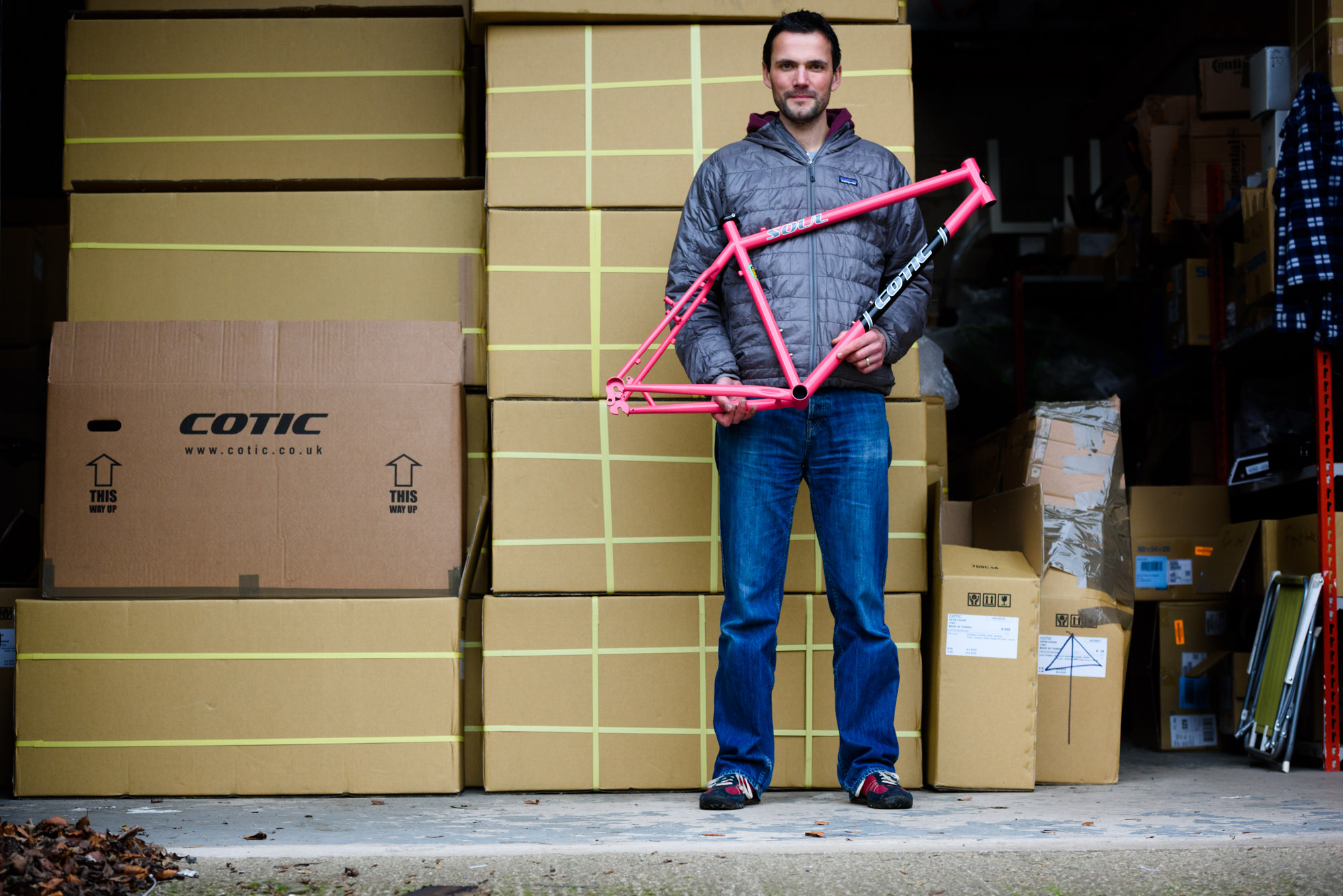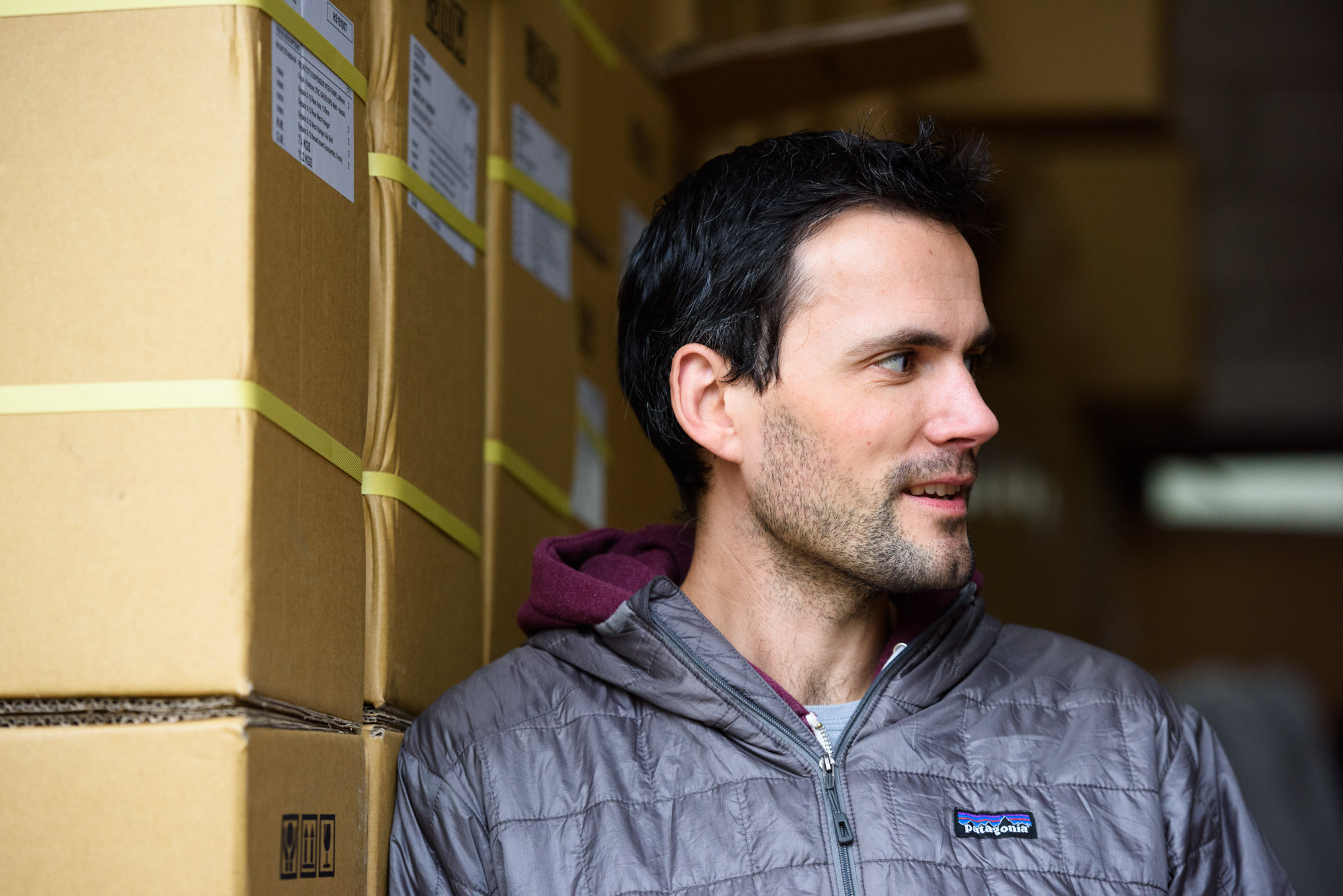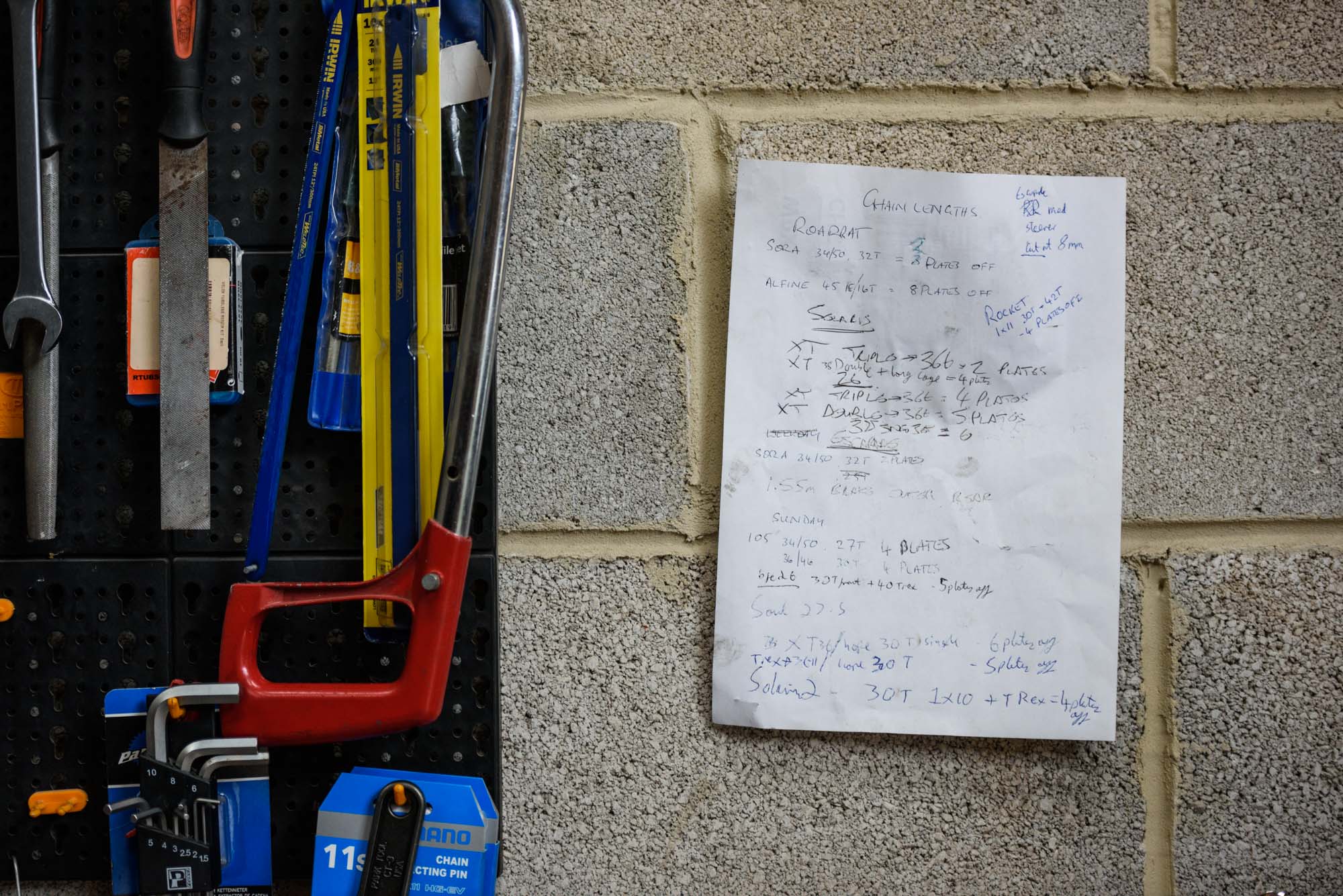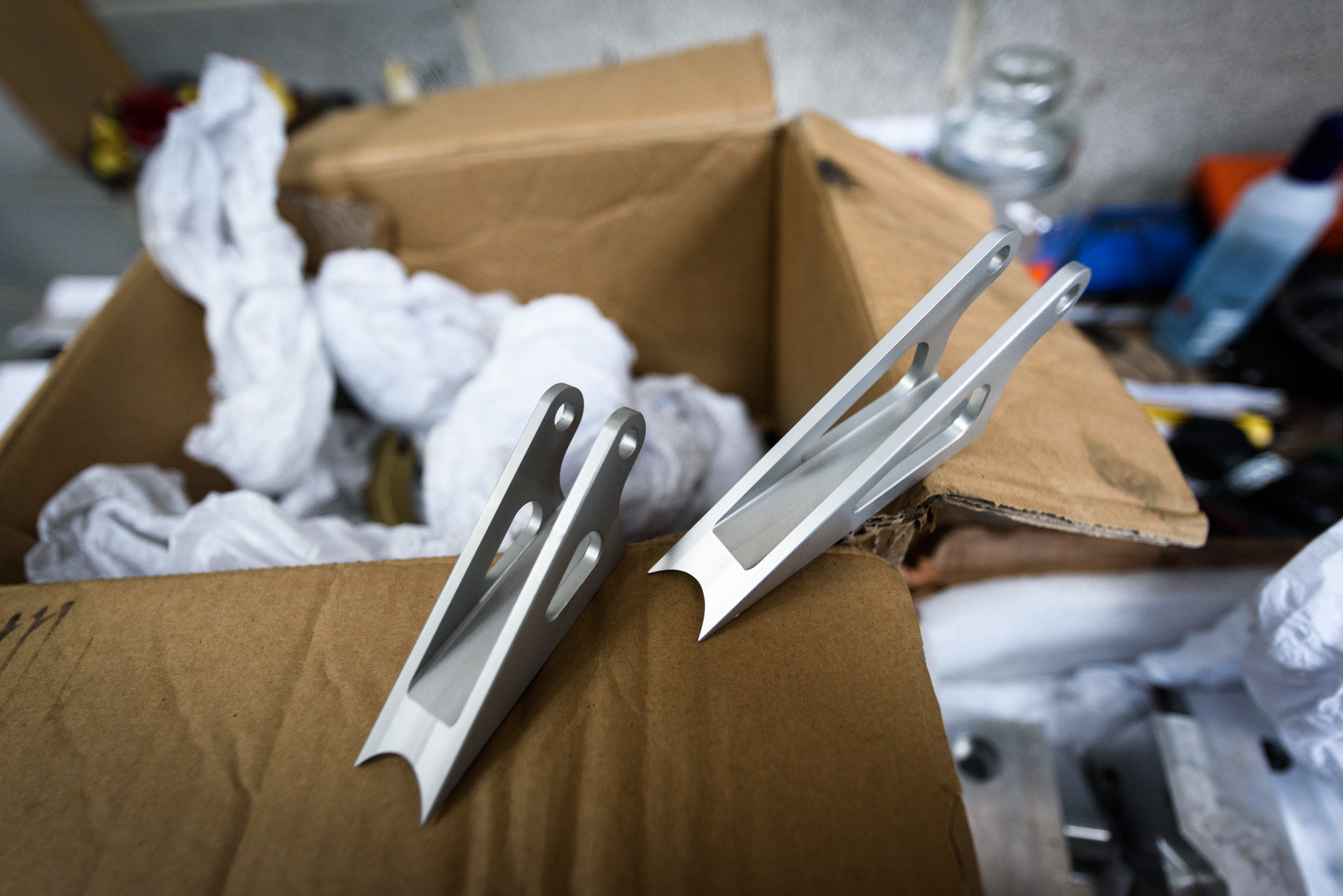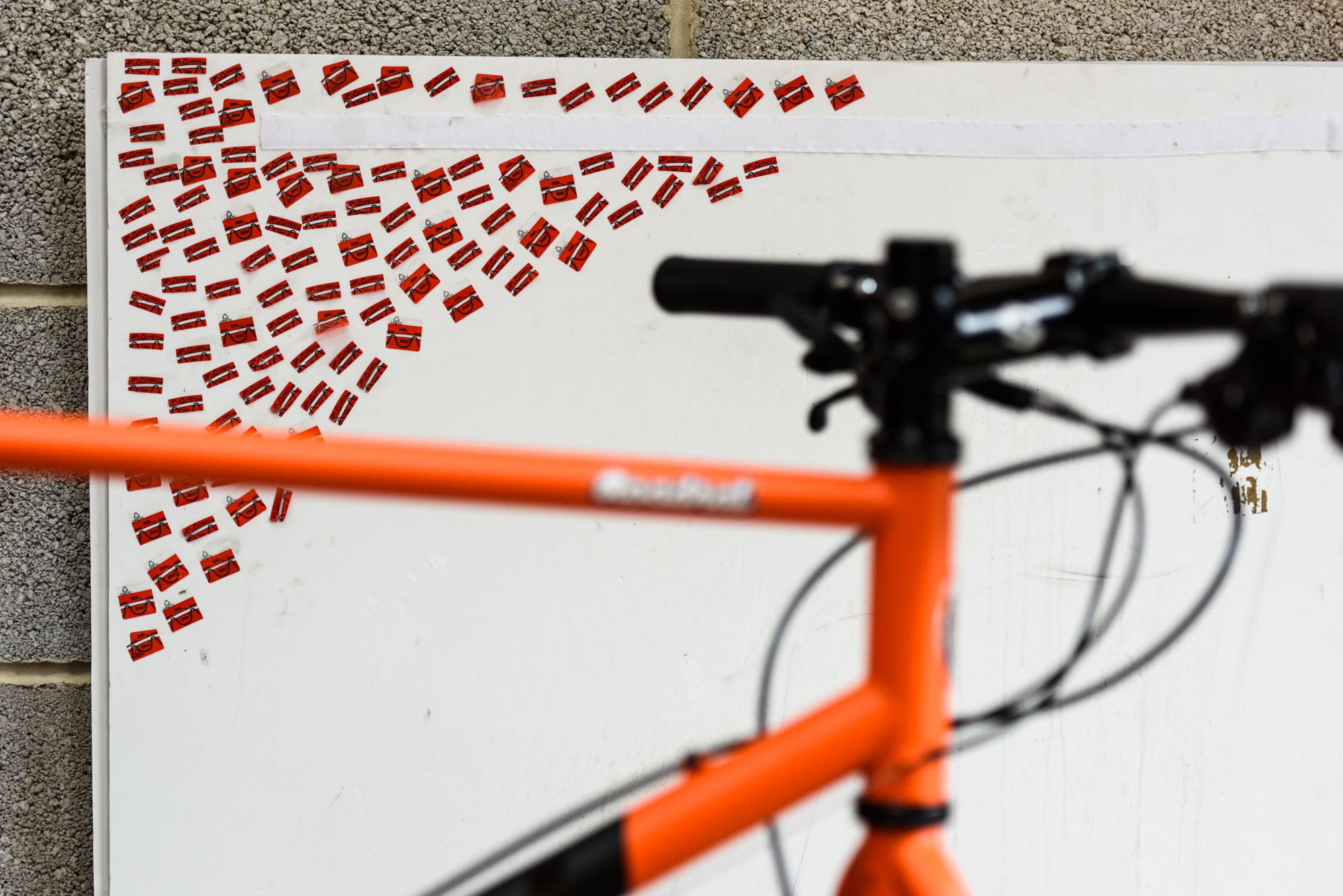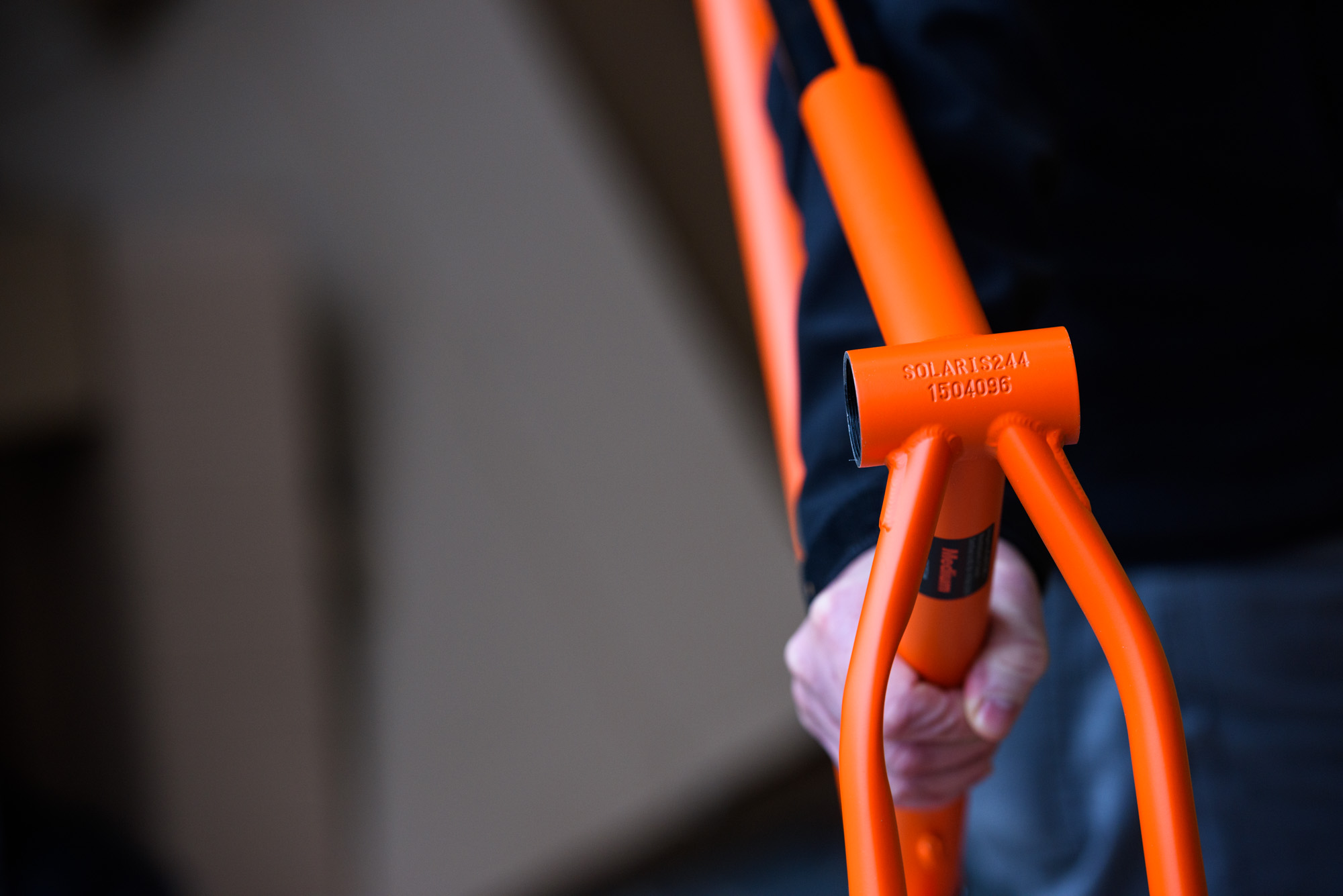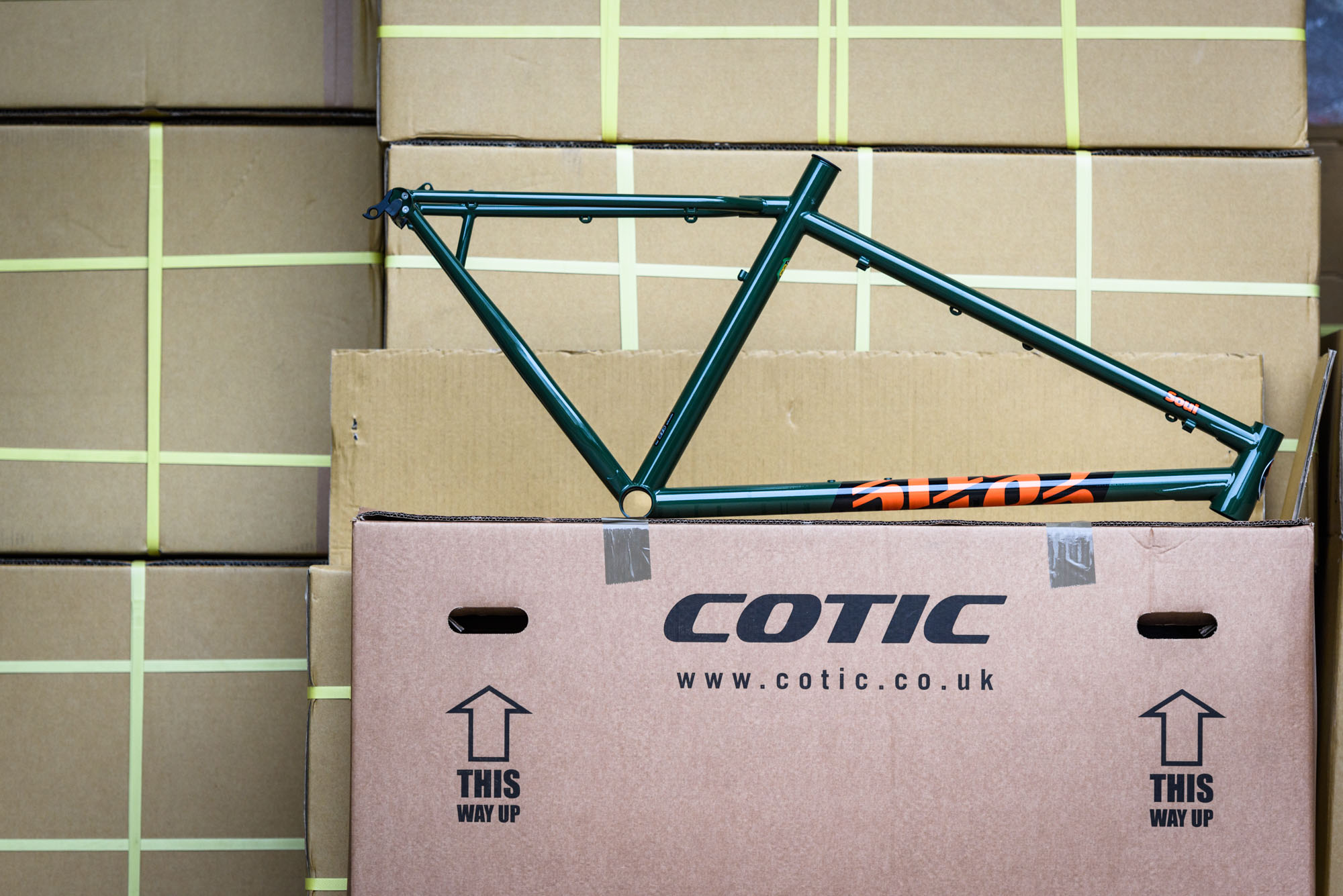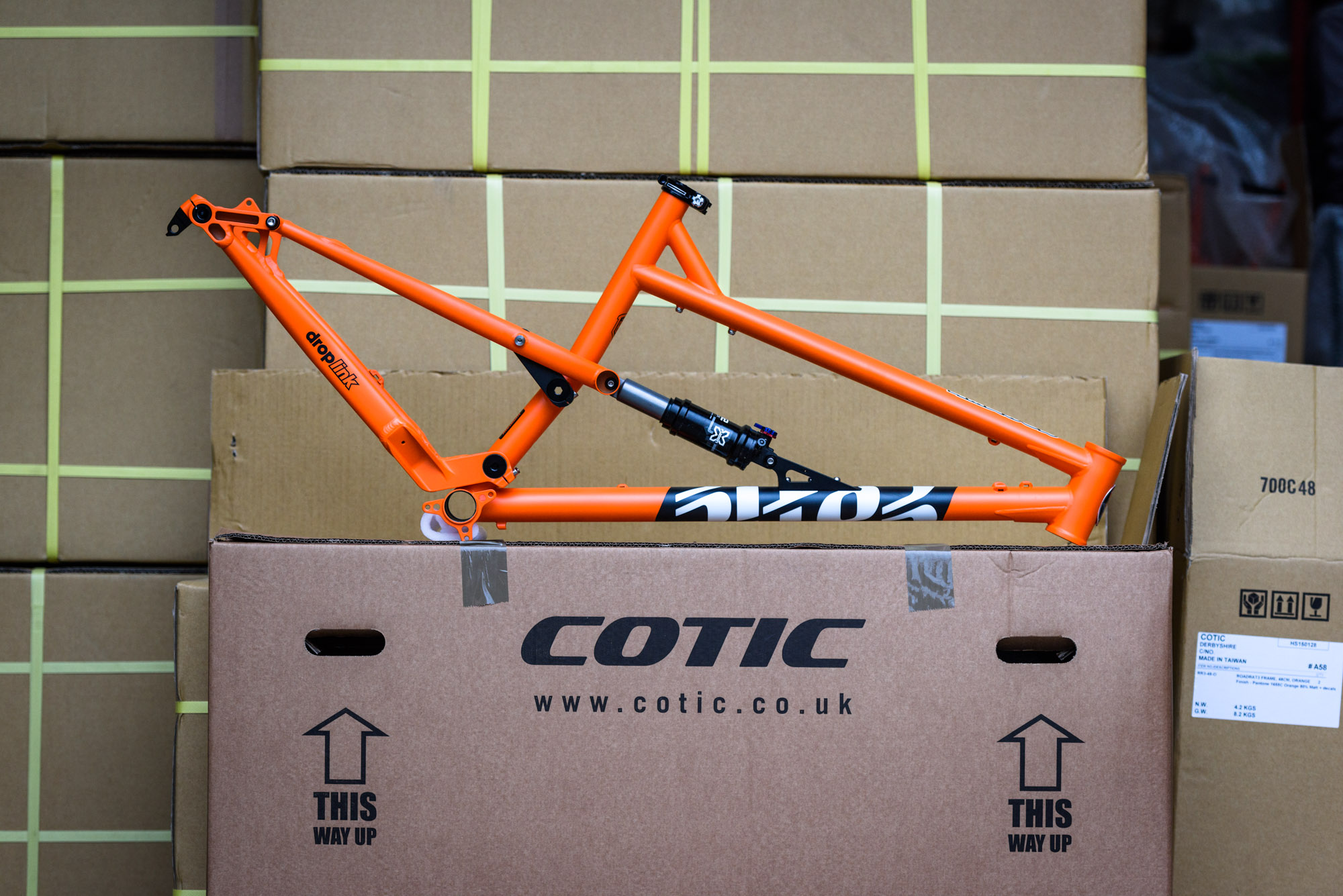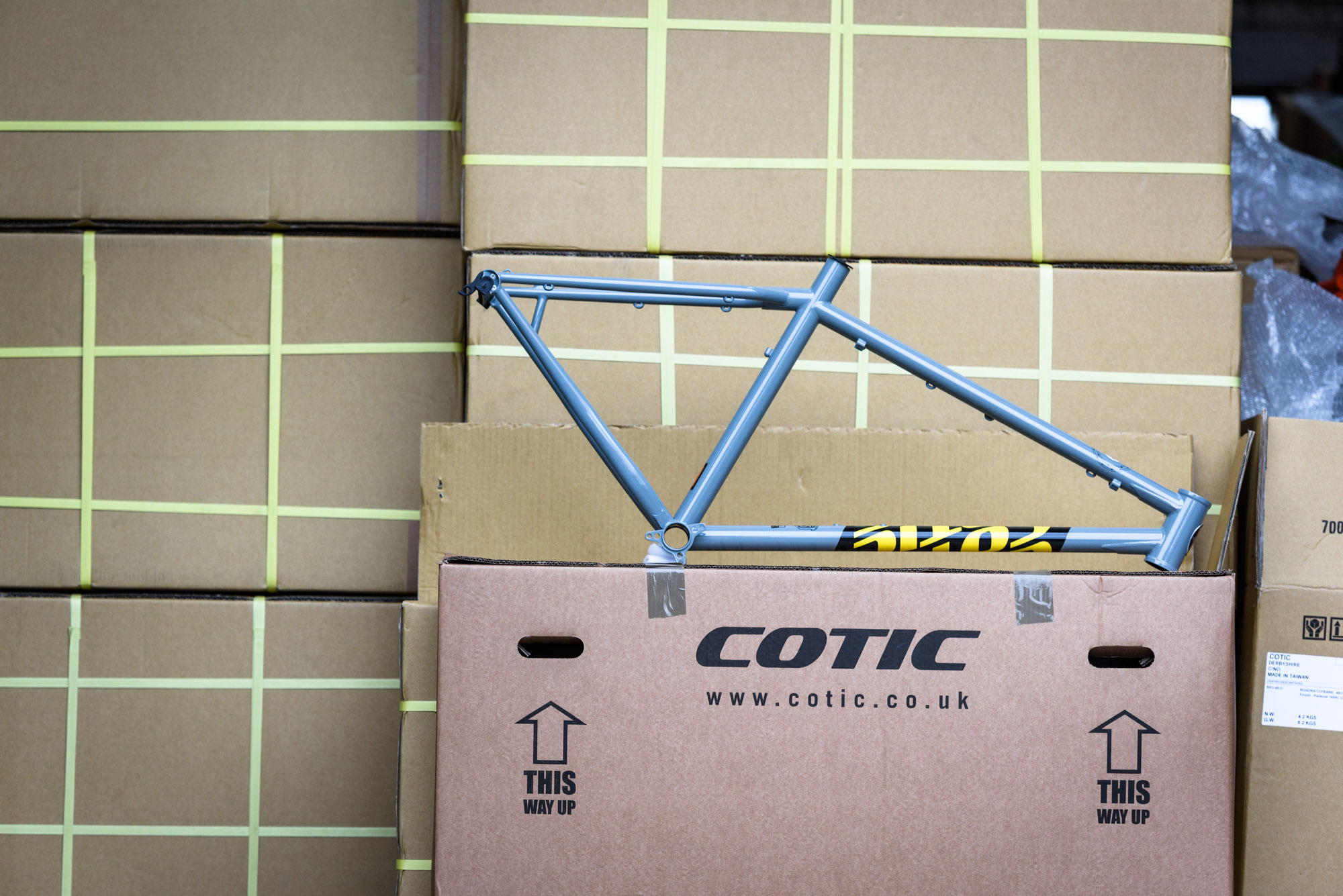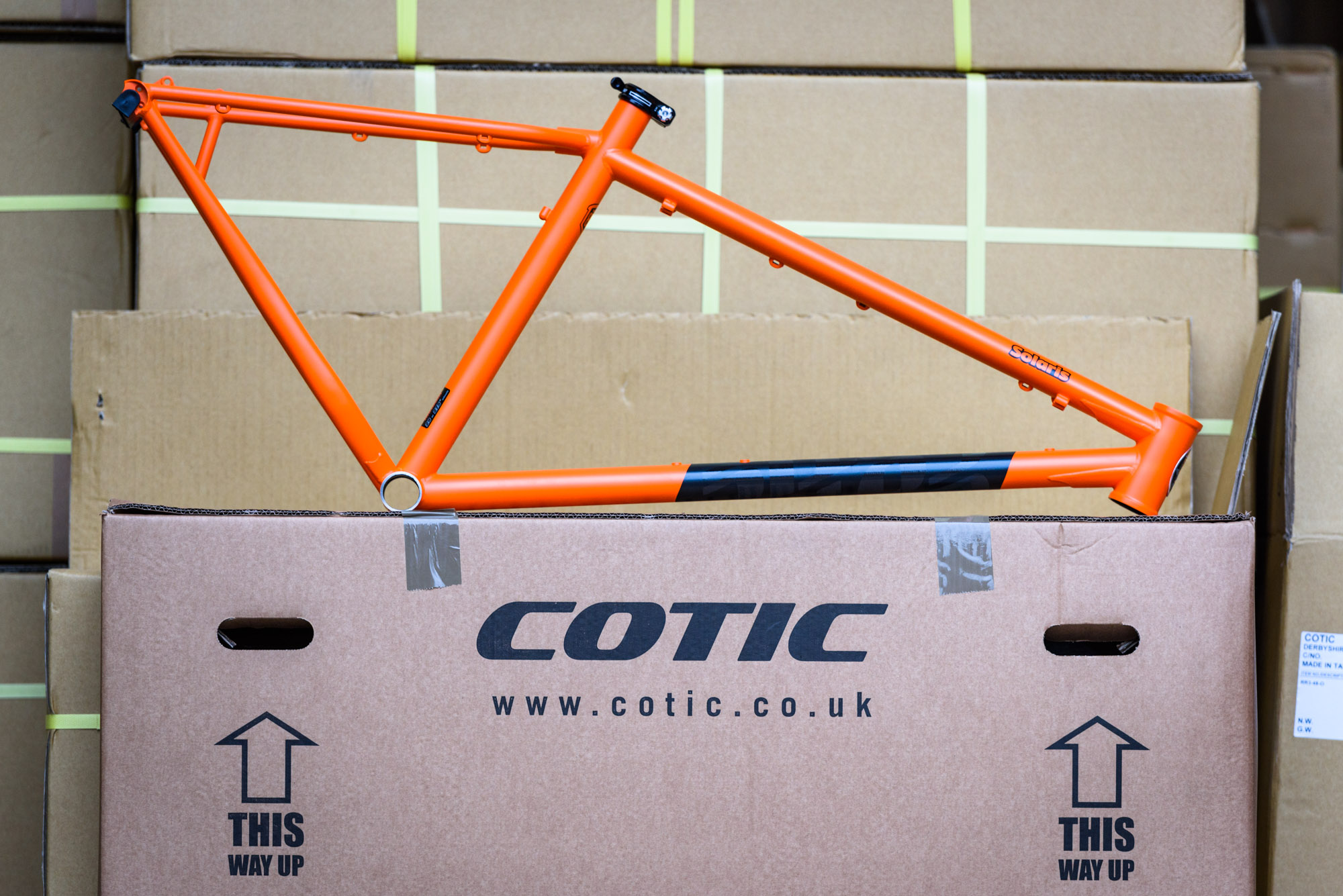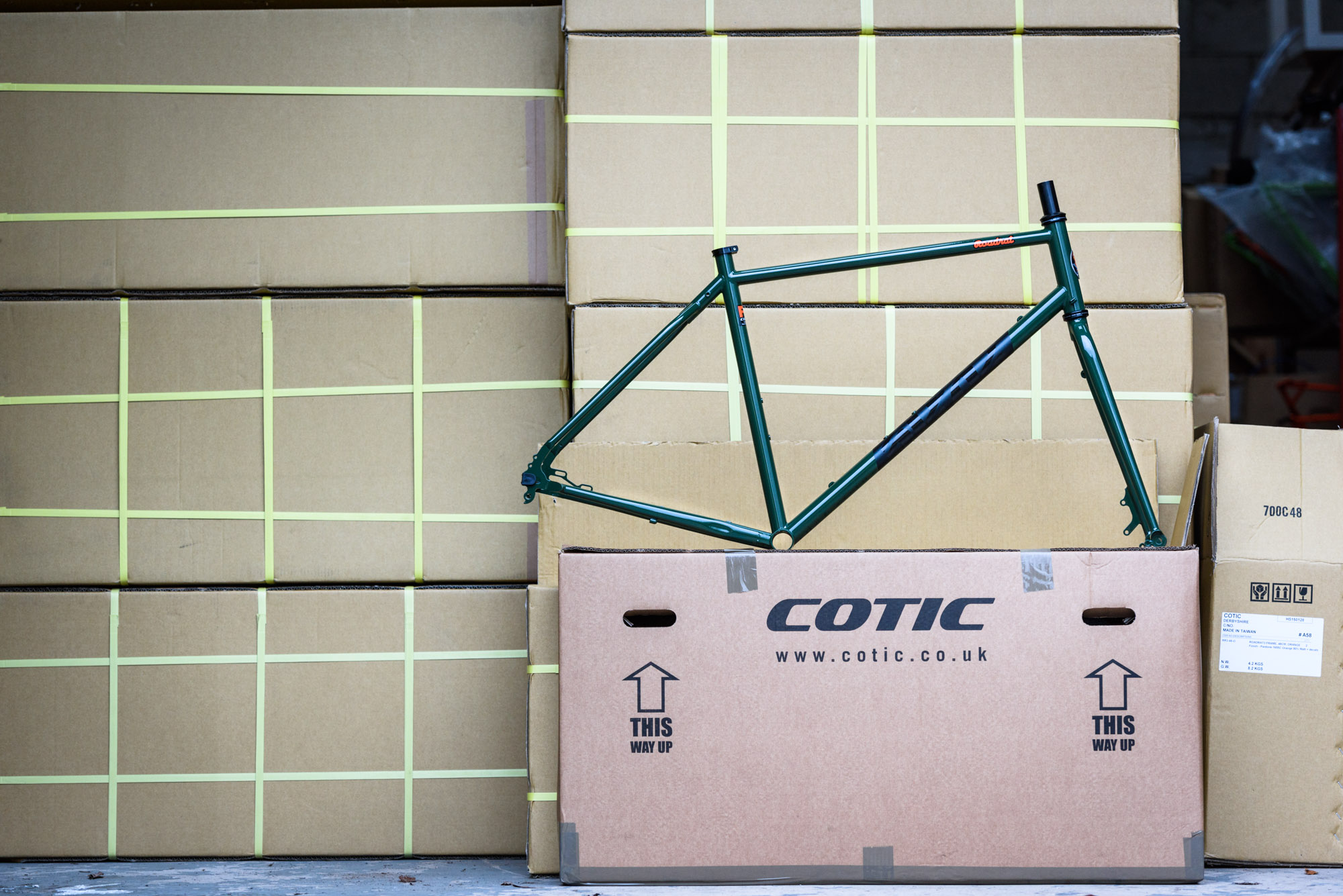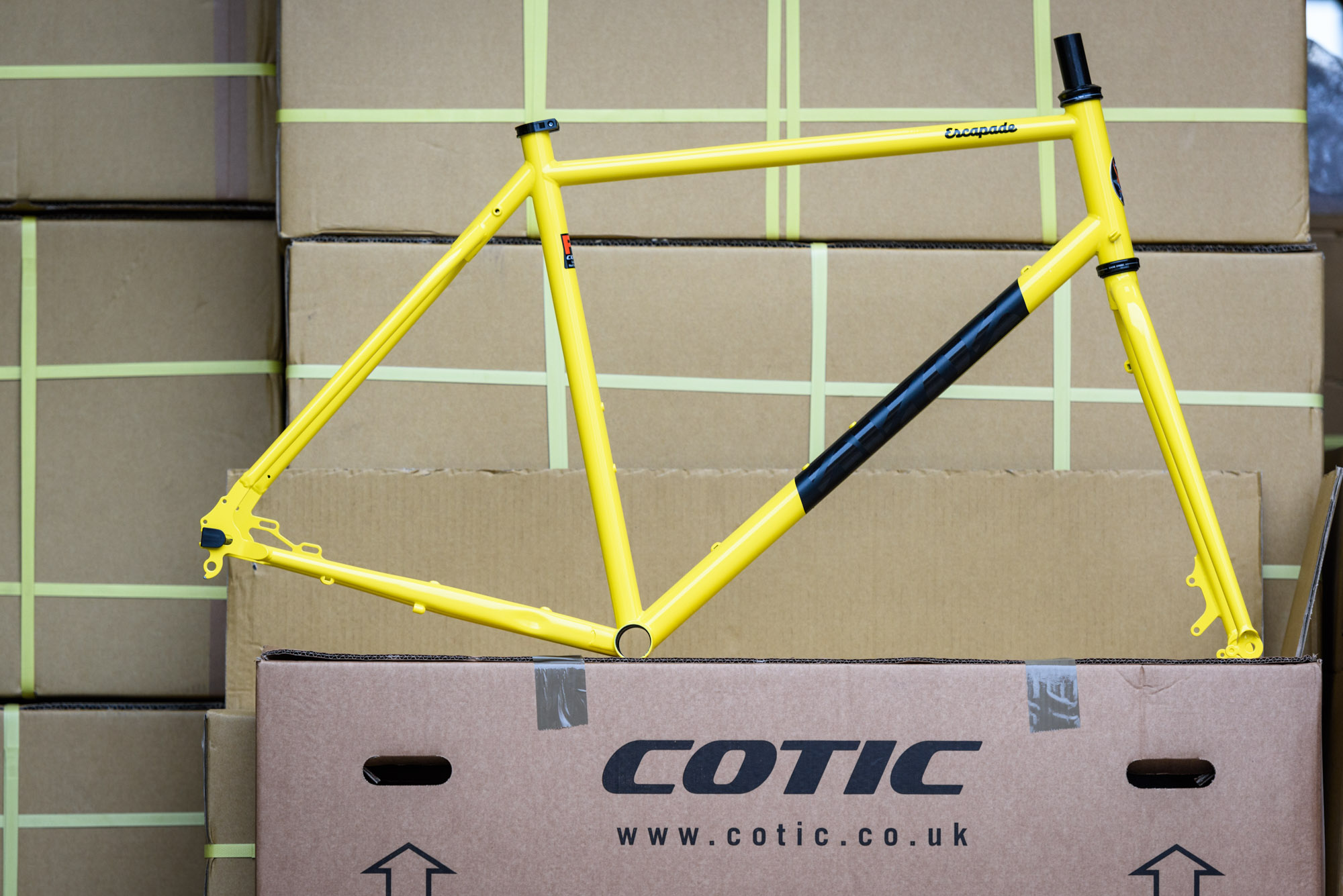SINCE STARTING THE COMPANY THE ONLY TIME I’VE WORN A SUIT IS TO THE FUNERAL OF A WHEELSIZE
Words by Dave Anderson, photos by Sim Mainey
Sometimes you’re at a press launch and there’s one statement that really catches your attention “Since starting the company, the only time I’ve worn a suit is to the funeral of a wheel size” did it for us, so we decided to delve a bit deeper into the ethos and history of the Sheffield based Cotic Bikes
RADventure: Do you want to start by giving us a history of Cotic, the beginning, and how it all came about?
Cy Turner: I’ve always wanted to be an engineer and design things, scribbling down bikes and stuff. When I stopped downhill racing, in 2000ish, I bought a hardtail; a steel Kona that was a bit too small for me and I put massive 100m forks on it and a really short 90mm stem and I rode that around. But it was all wrong, because the forks were way too long (for the frame) and it didn’t have enough clearance at the back, didn’t have disc brake mounts, all that kind of stuff.
So basically the Soul grew out of my frustration at that bike, there were certain things about that bike I absolutely loved but there were some I didn’t like. So I measured it up, sat down and improved things as I saw it; much longer top tube, properly designed for longer forks. I’ve always been a steel hardtail fan, right through, I’d tried a few aluminium bikes but hadn’t really liked them so I wanted it to be steel and Reynolds 853 was pretty much the strongest thing you can buy so it meant that I could make it nice and light.
I was actually quite deep into talks with Dave Yates to just make me one for my own amazement, I’d started going on the Singletrack forum and Shaun Murray, one of the original founders of the site, saw one of my posts about how I’d designed this frame and said “see what Brant (Richards) thinks of this”. So Brant, with a due sense of weariness and trepidation, an occupational hazard when you’re a bike designer is you get emails from people saying “I’ve got this brilliant idea for a bike”. I sent him a full CAD production drawing and Brant said “we can get some of these made, get you a couple of prototypes”. So I thought nothing ventured nothing gained, at least get the prototypes; and they were good – lots of people rode them and said they were really good – so I thought I might be onto something here.
My mate Kelvin, who still does the graphics and website and stuff, was willing to build me a website for frames and forks and stuff, my other mate Niall designed the first graphics and logo for some bike bits. I got a massive loan as I still had a day job, I thought if I only sell three I can probably cover the loan so I’ll have a go, have some fun, and it was a casual as that; there was no business plan apart from ‘this is a cool bike that people seem to like, so we’ll have a go’.
I heard a story about pink frames…
That’s true, that is very true. I had to smile through gritted teeth at that one. So what happened was we couldn’t find an orange that we liked over there (Taiwan), but we wanted to do an orange and a more conservative colour so we ordered gloss battleship grey. We were going to put some bright decals on them in the UK, and the colour code for gloss grey was 817, but Brant had done those pink Inbreds and they were 853 as well. They hadn’t told the agent that my frames were for a new customer so they thought Brant was making some more 853 frames and he’d made a mistake on the colour code, 718 is pink, so my frames arrived painted up in 718 which is Barbie pink.
So how did you sort that one?
So because we were going to re-coat half of them in the UK anyway in orange, we had a shotblaster and powdercoater in Nottingham who were going to do that for us, we ended up having to do it for all of them. So it wasn’t the end of the world, because we already had a solution in place, but yeah. Brant’s still got a picture of me holding this (pink) frame, trying to smile.
You didn’t keep any as limited editions then?
Here’s the funny thing. We thought ‘no one’s going to want one of these’ but we ended up selling two, two people saw them and wanted them. One was some guy up in Scotland, I think he’s still got it, the other one went to the Netherlands. Anyway two years ago was the tenth anniversary of Cotic, we started in June 2003, so I sent out a newsletter about our history and talked about the Barbie pink and the guy who bought the frame emailed me and said “I’m the guy that bought the pink frame, and here’s the thing, I never built it. I still have it but it was a present from my now ex-wife”. There was this whole story about how he’d fallen out with the frame, because there was this whole personal backstory, but he’d never sold it and he still had it brand new in the box. So I said “how about I send you a brand new Mk3, fully tapered steerer, dropper seatpost all mod cons Soul in exchange”. He said that would be awesome, so we now have that pink bike, it’s in the museum boxes up at the warehouse.
So we’ve got the original prototype, with the v brake bosses hacksawed off and filed down, and there’s the only Mk1 Soul in pink brand new in the box. What an awesome story.
I think one of the things that identifies Cotic is that strong community of riders/owners.
Oh for sure, it was one of the things that got us going. You’d get these people that you are forever grateful and indebted to that had read the great reviews in Singletrack, Steve Worland loved the bike which was like… I’d literally grown up reading this guy. I read one of his first reviews when I was twelve, so he asked me to go to his office and we met and he loved it. He said how it was like the bike he’d wanted Chris DeKerf to build him, and I was going “this is the coolest moment of my life”. He wrote this lovely big half page picture and write up in What Mountain Bike mag. BikeMagic’s Mike Davis wrote a nice piece, so we got some great PR, and great press.
Off the back of all that some brave people ordered the frames, so we sold twenty straight off the first shipment and we did them custom T shirts because it had been delayed, we had these Soul Rider tees with individual numbers on the back, so there’s twenty five guys out there with them. I was mortified that we were messing these people around.
What happens is you get these little enclaves of Cotic owners, because one guy would buy it, and he’d be loving this bike, then his mate would ride it and then he’d order one. So you’d get these little pockets where there were four or five people with them, for the first two or three years there were these little enclaves. There’s so many out there now it almost becomes self-propagating, it still spreads out through this community.
When you do something new are you worried about upsetting that ground base, will they go along with what you do?
You have to be aware of it but you can’t… The amount of times we consult with our customers, like the mailing list is a really powerful thing for that, we have over 3000 people on it and it’s not a semi webpage ‘Buy Now!’ kind of thing. It’s a black and white email from me, from my personal email address, so when you get it if you press reply it comes to me. It’s a very powerful way of talking to people, you talk directly to them and you get feedback people saying “I don’t think you should do that” or “maybe that would be all right”. Sometimes we just think ‘this is right, we’re going to do this’ and sometimes you get people coming back and saying “I was one of the naysayers but actually that’s really good”.
You have to trust your instincts, but also you have to look to new markets as well, things like the Rocket opened us up to a whole new market, very few sales were existing Cotic owners because it was a very different kind of bike. I still maintain you can build it up as a very light trail bike and have loads of fun on it. People who buy our steel hardtails maybe do a less extreme kind of riding particularly the Soul and Solaris which is more for fast singletrack riding, they’re a bit more conservative about what they want from a bike. So they look at the Rocket and see a 66 degree head angle, 30 pound bike weight, 160mm travel and they just think there’s too much bike. Next year we’ll be doing a shorter travel Rocket for exactly those people. That is the bike for Soul owners and Solaris owners.
A couple of years ago we did a consultation, because we had a four-inch travel aluminium bike which was pretty light and we had a five-inch version of the Rocket which was steel, Paul loved the four-inch bike and I loved the five-inch, they were both good bikes but we just couldn’t decide. So we went out to the Facebook group and the mailing list and said we’re going to make one of these bikes what do you think? The overwhelming majority of our existing users said they “loved the idea of the Rocket but it’s just too much bike for us”, so they liked the idea of the clean lines, made from steel, everything like that, they just wanted something more like their Soul or Solaris, that was less ‘scary’.
Yet, three years later you’ve got people like Chris Porter saying 63 is the new 66.
You’ve got to be true to yourself, at the end of the day I only ride my hardtail now not even 5% of the time. I only ride my Rocket because I live here in Sheffield and the surrounding Peak District where riding a five-inch/six-inch travel trail or enduro bike is the perfect thing. We winch to the top of the hills and then we hammer back down them on really rocky trails, and as much fun as that is on a hardtail my considered opinion at the moment is that I have more fun doing that on my full suss bike, so that’s the bike I’ll reach for more often than not. Although I love all of our hardtails, and I still think they’re great, hand on heart the kind of riding I do now is not really hardtail riding. So I have to be true to that, I’m not a salesman I’m an engineer.
So bikes are shaped by a combination of place and time, aren’t they? They need an evolution of the riding scene to become relevant.
For sure. It’s geographical as well, even though I’ve only moved forty miles up the road from Nottingham where I lived when I founded Cotic, the nature of the riding is completely different. I did ride up here, only once or twice a month, so riding that on my Soul with big tyres and brakes and good handling was just loads of fun, but the week in week out riding we did down in Nottingham in the forest, where you’re just screaming amongst the trees that was hardtail country. We all had fast hardtails. I remember coming out on one of my first (Sheffield) night rides, I turned up all nervous on my Soul even with 130mm forks on it. This was early 2008 and the locals, even then, were all riding five or six-inch travel bikes; Metas, Patriots, that kind of thing. Despite having a five or six pound disadvantage to my hardtail smashing me up the hills then disappearing off down the other side. I still have visions where we did this one particular trail, which is one of my favourites, in the dark in the middle of winter, it’s a mass of boulders and grit and peat, lines everywhere with drops and holes, I just remember watching the blinky red lights disappearing off into the distance and thinking ‘I don’t know where I am’.
Sheffield is pretty much a hotbed for that?
Sheffield is nuts for that at the moment. It’s such a cool place to be. I think it’s one of the places to be for mountain biking at the moment there’s so much going on. Not just the trails but the scene, the advocacy, the events. It’s amazing.
So it was pretty natural for Cotic to get involved in all that?
I volunteer for Ride Sheffield. That just came about because a friend of a friend was going to a meeting so I went along and just got involved. One of the things that makes Ride Sheffield work so well is that even though there’s about ten of us who are the main core volunteers there’s three or four of us who have relatively flexible jobs so we can go to meetings during the day. That’s one of the things that helps move it along because we’re not asking Councillors to have meetings in the evenings. I got involved because I could and I wanted to.
Getting involved in the Sheffield scene, it was mainly Joe Bowman before he was Steel City Media and before he was big time (laughs), he invited me, he got in touch. Him and Dunc were doing the This Is Sheffield blog and they got in touch, they were doing photo’s and local video content and nick was doing some of the mates races and it was all beginning to come together. Joe was involved in organising the first Steel City Downhill and he wanted to know if I wanted to come along with a stand. It was a couple of hundred quid which would go towards the race and go into the trails. That was the catalyst. In the third year 3000 people turned up, the biggest crowd this side of Fort William, it was three deep all the way up the course; a tunnel of sound all the way down the hill. It’s amazing, absolutely amazing, better than Christmas, it’s my favourite day of the year.
And that’s why you got the team jerseys made with your name on?
That was me being… well it was rude not to. You grow up through the sport and you see all these cool jerseys, that was the first year that we had the Rocket and we did the enduro team. Chay Granby and Josh Lewis was on the team who was working for Royal at the time, and he introduced me to Nick. So we worked together to get some kit, he sent me the designs of the jersey with the backs with Josh Lewis and Chay Granby on and I was like ‘that’s the coolest thing I’ve ever seen’. Royal Racing kit with Cotic on it, and I said can I be a really, really sad ego person and can you do one with my name on it? And Nick sent the design straight back saying he was going to do it as a surprise. That was awesome.
I guess that was kind of the turning point. That was when it really got… when the Rocket and the videos we were doing with Joe got really big. Rocketman had gone massive, the team, and then you’re there at this local race in blazing sunshine, and you know everyone, and you’re wearing Royal Racing kit with your name on, and you’re just buzzing your tits off; at how well it’s all turned out.
‘What Would Rocketman Ride’ – Cotic/Steel City Media
Is it a two way thing? Is Sheffield influencing Cotic as much as Cotic invests in Sheffield?
Yes, because I think I do. Sheffield is home, I have a very emotional bond to the city and because Cotic is very much a part of me that flows into the product and the company.
And that was important to show for the Rocket275 launch?
Yes, you needed to understand that the bike was born and bred right there. We rode right past my house. It was real. It was the place I ride, and we ride. It was a good place to tell the story definitely. For bringing the Rocket back and where we are right now, it felt like the right thing to do.
How hard is it to be a relatively small fish swimming with the big fish? We remember you saying you went along to Eurobike and 27.5 was there and you felt like you’d been mugged?
After something like that happens you make a very big effort to try and make the right contacts so it doesn’t happen again and that’s why the Solaris was available with a 27.5+ option before Eurobike. I knew it was coming and I’d had the samples the previous January. You don’t necessarily need to be bigger but you need the right contacts further up the food chain. But interestingly plus sized hasn’t gone as big as everyone expected, I think the reason for that is because 27.5 did. Plus was just the next thing that came along, and with my product manager head on I thought I can’t be left behind with this one. So we all did something with this one, and the public raised a very collective meh. We’ve sold some don’t get me wrong, but it’s not been as big as anyone thought it was going to be.
Enlarge
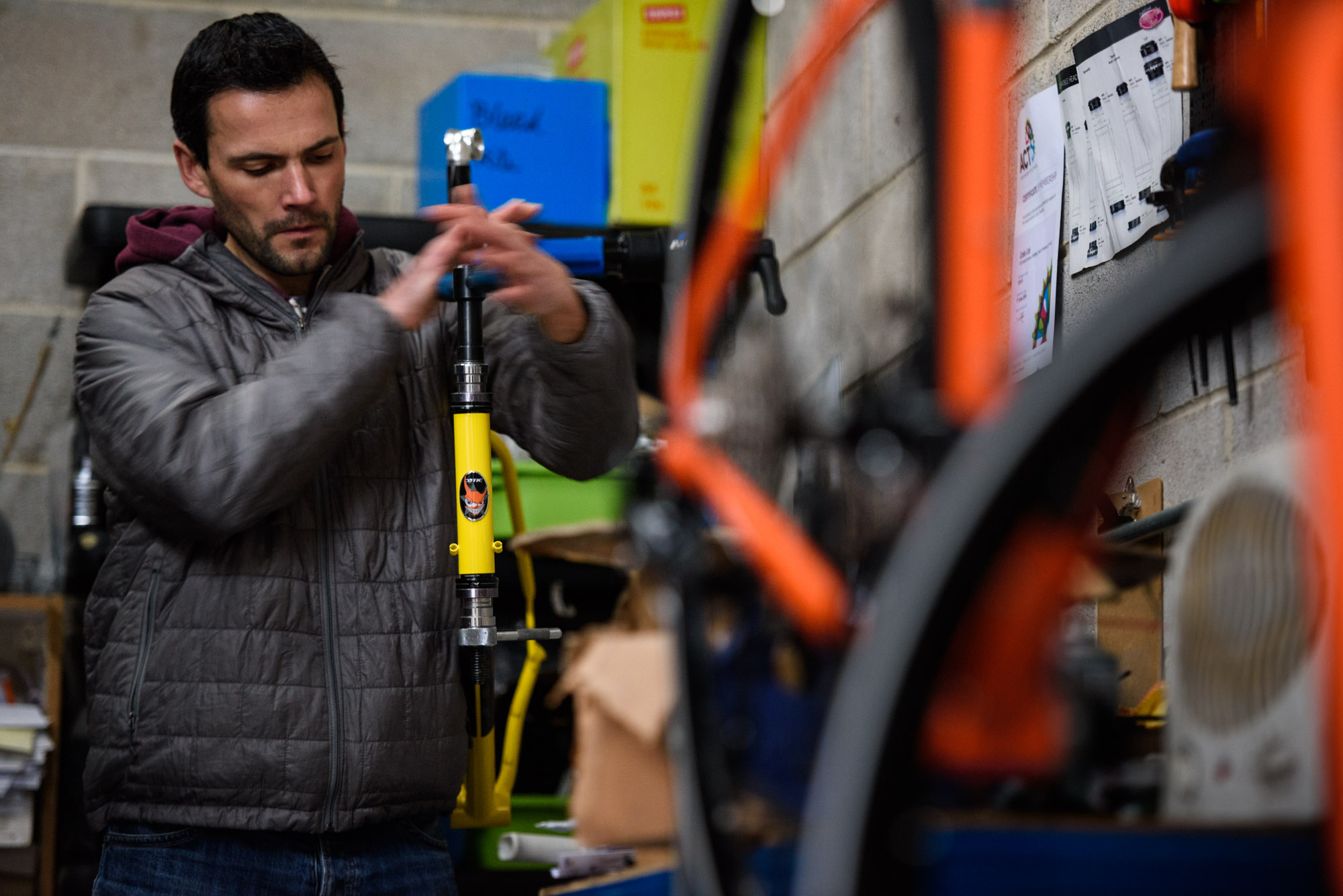
What advice do you have for a small start up, like you ten years ago?
The big thing I had was that I did it part-time for three years, I didn’t take any money out of the business apart from buying myself bike bits. It was almost as if the fact there was no plan was the key to its success. I didn’t give up my day job. I didn’t jump from my day job because Cotic had got bigger, I jumped because I went stress-pop. I’d got put on a horrendous contract with a horrendous customer, my first daughter had just been born and I forgot my wife’s birthday. I was so angry with myself, because I was so stressed with my job I’d become that guy. That guy that you poke fun of in the movies when he forgets his wife’s birthday, and I actually did that. I quit the next day. I didn’t have a plan I just said this has to stop. My accountant pointed out I had enough profit built up that I had at least a years worth to go at so Cotic could be my next thing. So it wasn’t actually my idea it was my accountants. I was such a duffer with business I didn’t even know that was the case.
But it allowed you to concentrate on designing bikes?
Yeah, it was relatively manageable. We were selling a couple of hundred frames a year. Me and my wife would box them up, she’d put the stickers on them because she’s got better fingers than me because she’s a physiotherapist. I’d do the invoices and put them in the boxes. We were a good team. So we’d do all that and then I’d take them to the post office on a Friday on my way home from work and that was how it worked.
It grew from people really liking the Soul, and then people really wanted a titanium one. Our factory in Taiwan happened to be the only one that did titanium so we got a couple of prototypes, then we did the Soda. I was riding to work a lot, but I’ve never massively got on with road bikes, I came from a BMX background into mountain biking so I never really did the road bike thing. I wasn’t getting on with it massively but then some cheap Mavic Speedcity wheels came up secondhand at the local shop, so I got them and boshed them in my Soul with some flat bars on it. Disk brakes and flat bars on a road bike? Interesting. That was where the Roadrat came from. One of my mates was riding his Soul at a BMX track, he kind of liked it but felt it was too flexy and not grr enough for that, the BFe grew out of that.
It was just me and my mates riding them and thinking ‘it’d be good if we had one of these’, then making it. Hang on, we’ve got a bike company!
So the Soul is in the middle and everything is an adaptation of it?
Very much so. The Soul has become like a talisman for us, and I sometimes wonder if I sound big-headed saying this, but I think it’s become iconic, it’s an iconic product. It’s been in continuous production, through its variations for thirteen years now and, unlike other products that have carried an iconic name onto very different bikes, I think it’s still very true to the original ethos of the frame.
When the 27.5 thing happened we generally had a policy of not just putting a wheelsize after an existing product name. But we saw 26 dying so fast that we had to call it the Soul275, because if we don’t the Soul will die. And I couldn’t have that! And it has died we don’t make the 26 inch Soul anymore.
And you were one of the people noticeable in supporting 26 inch.
I very quickly realised we couldn’t swim against the tide. The Soul275 is the fastest development of a frame we have ever done. We drove to Luchon in the first week of November with seven bikes in and on my car. It was November and the frames turned up and we had a production slot booked that would deliver frames the following March which was still due to be 26 inch frames because we had a two-year production schedule, that’s how scary it was. We had three wheel sizes, and we did laps and laps and laps.
We literally signed it off in a week. To be honest it wasn’t about any of the wheel sizes it was whether it was a good bike. We’d decided to introduce the new OFI geometry, it wasn’t just a Soul 26 with slightly bigger wheels, we’d completely changed the philosophy of how we laid out the frame for the rider. So it was ‘did we do our sums right?’.
I think a lot of people snuck in changes that they wanted to make anyway during that period.
The main thing I prefer about the new Soul275 is the new geometry, it had nothing to do with the wheel size, it just fitted me better. The new bike just worked better with modern stuff, and that’s always what we’ve done with the Soul it was never a retro design, that’s the tag line on some of our adverts “Modern Steel Hardtail” there’s nothing retro about it.
Tell us about the Cotic design ethos.
It came out of the development of the Rocket, because we wanted to do a full suspension bike, we always have. The Hemlock was a middling level of success, it had its issues but it sold and people liked it and I liked it. I designed it when I took on a lot of accepted wisdom in terms of what a full suspension bike ought to look like, what it should be made from; people made full suspension bikes out of aluminium, that’s what you do… I’ve always been an admirer of Turner bikes as well so I was swayed by the fact I liked that aesthetic. So there was an element of that in the Hemlock.
The Hemlock was coming to the end of its life and what really precipitated what became known as the fast bike project, which became the Rocket, was a couple of things. Firstly I’d been in Sheffield for a couple of years having my ass handed to me by the local night riding lads, so I needed to design myself a better, faster bike. So there was that driving it, that I lived here and needed a more evolved full suspension bike, but also there was the genesis of the modern Cotic look.
The 09-10 model year, where we introduced the Soul Mk2, we launched all the bikes at the London Bike Show; we had the Soul, the BFe and all these interesting looking RoadRats and then the was the Hemlock on the end of the stand in anodised black with massive aluminium tubes. It looked like another brand had just snuck one of their bikes onto our stand. It stood out for all the wrong reasons. I’d emailed around friends for their feedback on what a new bike should look like and one of them said ‘why don’t you hang a swingarm off a BFe front triangle” and I almost dismissed it out of hand, but it was right after seeing the Hemlock on the stand.
We’d started to talk about what is Cotic? I’d never really sat down and thought about it before. We all got together, sat down and tried to define what is Cotic, what is it about the hardtails we want to bring to a full suspension bike, what does a Cotic look like?
That was where our five tenets came from:
Grace – the look of the steel tubes, the clean lines.
Clean lines – I actively don’t like the hydroformed swoopy look. Clean, pared back looking bikes.
Durability – we don’t just use steel tubes for looks, it’s because they last and I love that. I hate the disposable economy I love the fact we have guys with Souls that are ten to twelve years old and they’re coming back to us to get a new sticker set because they’re getting it resprayed.
Interactive – because we don’t like dull bikes, particularly with full suspension.
Fun – it’s a pastime and we do it for fun.
That became the mantra for the project, but it also became what Cotic is. It’s the mantra for everything we do in design. They’re so ingrained in the company now.
Do you think these five tenets simplifies the design process?
It does, because it gives you something to hang all your decisions off. I never realised how powerful it was until we had it. Instead of saying ‘is this going to live up to the soul?’ you can stay quite forward-looking and know that if you tick the boxes it will live up to it without having to look over your shoulder all the time. I’ve always been about making the best bike I know how, always about using the most modern idea.
We came up with the geometry for the Rocket by putting anglesets in the Hemlock, I remember putting a two degree angleset in it in 2009 and thinking that’ll never work.
Even as a designer it’s hard not to get sucked in to the accepted wisdom, to think outside the box, but you have to push past it and just go and try it. It’s going to cost you a ride if nothing else and you’ll still have been out on your bike. Then you come back from that ride and you’ve just seen the future.
To come out with a bike in 2012 with 160mm forks and a 65.5 degree headangle that was pretty radical. The geometry on the Rocket275 hasn’t evolved far from that, because it’s still very much of the moment. It’s longer reach, but that geometry is pretty mainstream. It’s a good thing, but it makes me wonder ‘am I missing something?’. But then going radical will win you some customers, but people are pretty conservative when they’re putting down their own money until they’ve ridden it. You have to be aware of that, you have to have another offering.
The Cotic Range
Soul
The Soul is the original Cotic hardtail frame and centrepiece of the brand.
Soul
Rocket
The 150mm steel full suspension trail bike.
Rocket
BFe
The Soul’s hardcore sibling.
BFe
Solaris
29″ wheels done the Cotic way.
Solaris
RoadRat
Cotic’s first foray into the world of not-mountainbikes but with room for reasonably big tyres.
RoadRat
Escapade
For when you need a not-mountainbike in your life. N+1…
Escapade
Listen to the full interview
Thanks to Cy for his time and for the full English.
cotic.co.uk

